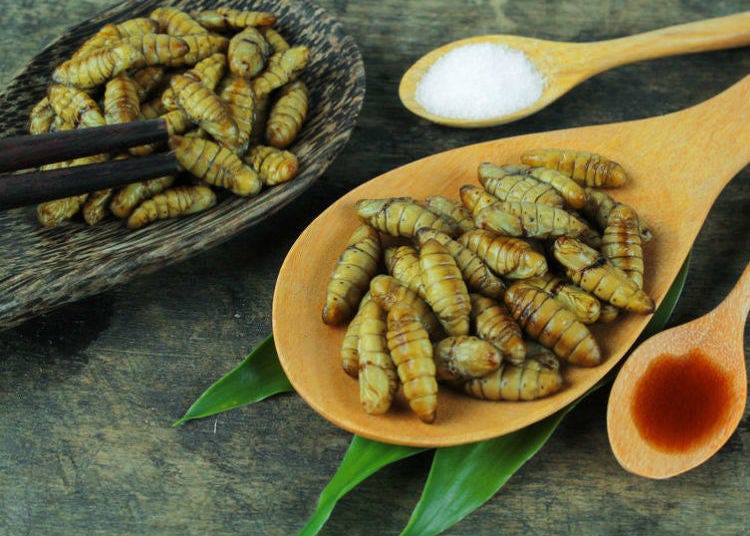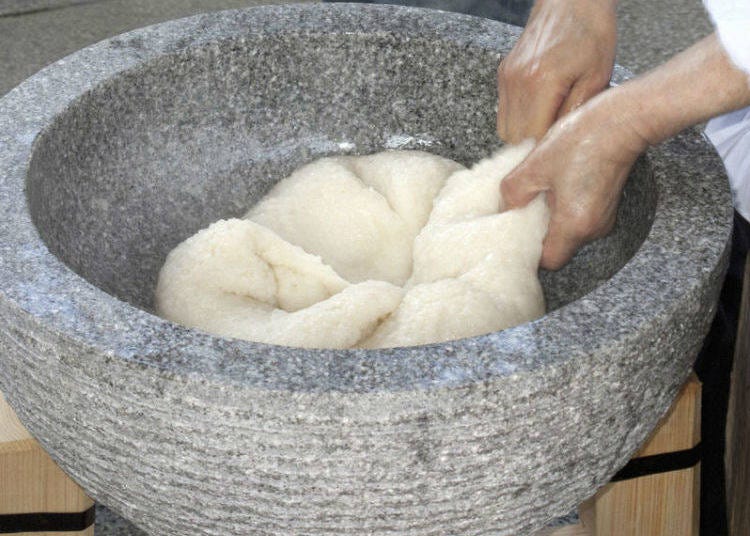
Japanese food is a favorite for people around the world, and many visitors to Japan look forward to trying out popular fare like yakiniku, takoyaki, okonomiyaki, shabu shabu and more!
Beyond these popular items is a large variety of dishes that might be considered unusual in the West - and as a result they aren't necessarily covered as often. Although they are less well-known abroad, these foods are much more common in Japan, and if you're looking to try something truly unique, be sure to give these a go for a memorable dining experience on your next visit!
1. Fugu

Fugu: you may have heard the Japanese name for the poisonous puffer fish before, as well as its infamous reputation for carrying the risk of death if prepared incorrectly (and, to boot, the toxin has no known antidote).
In Japan, fugu is prepared by experts who train for years on how to remove the fish’s highly toxic organs without contaminating the rest of the meat. As a result: can you guess how many people die in Japan each year from fugu poisoning? A surprisingly low number: for the period of 2005-2016, the Tokyo Metropolitan Government puts the total number of fugu-related deaths at just 9. And yet the risk is enough to concern most! For daring eaters hoping to give it a go, fugu can be enjoyed in dishes such as fugu sashimi, called “tessa”; karaage (fried fugu); and fugu hot pot, called “tecchiri”.
2. Chinmi

Chinmi is the title given to select unusual Japanese delicacies that are an acquired taste. It’s an easy way to identify which dishes even Japanese people find somewhat peculiar, as opposed to those foreign only to Western palates.
Perhaps the most classic example of chinmi is uni, the delicate orange or golden-colored reproductive organs of the sea urchin, which may be eaten raw, steamed, or cooked into a creamy soup or pasta.
Two additional examples of chinmi that might make even Japanese people raise eyebrows are karasumi (mullet roe pickled in salt) and konowata (fermented sea cucumber innards). These are typically enjoyed alongside glasses of sake or beer, which may help the unusual flavors go down a bit more easily.
3. Shirako

Shirako is a creamy delicacy that’s enjoyed during the wintertime. When translated directly into English, the word means “cod milt”, or the sperm from male cod. White in color and very soft on the palate, shirako can be eaten raw with a splash of ponzu, a citrus and soy sauce dressing, or cooked in a nabe hot pot dish.
4. Neba Neba

Neba neba is a unique class of Japanese foods that is very popular within Japan, but that some foreigners may find somewhat strange or off-putting at first. Many of these foods have intriguing textures, being naturally sticky or slimy, and are often eaten over hot rice and include things such as okra, tororo (grated yam), and sticky nameko mushrooms. These foods owe much of their popularity to the fact that they are seen as a restorative food that has a cooling effect on the body in hot weather—perfect for those steamy Japanese summers.
5. Natto

A type of neba neba food, natto is unique and popular enough to get its own separate description. Made of sticky fermented soybeans, natto has a colorful smell that most agree is not its best characteristic. A polarizing food, natto has plenty of die-hard fans as well as a large number of folks in Japan who would rather do without it. Natto is typically sold in individual packages which are whipped with tare sauce and spicy mustard using chopsticks until the mixture becomes frothy, then poured over hot rice.
6. Wafu/Yoshoku

Wafu and yoshoku may seem like two types of unusual Japanese foods to Western visitors, but both are very popular within Japan.
Wafu means “Japanese-style” and refers to dishes like pasta and pizza prepared with local ingredients to appeal to Japanese tastes. Some examples include uni cream pasta and pizza topped with grated nori seaweed or shirasu (baby anchovies).
Yoshoku means “Western-style Japanese food” and include dishes like curry rice, hambagu (Hamburg steak), and omurice (omelette rice) which are not traditionally Japanese food but which became popular during the Meiji era as Japan sought to modernize and adopt a more Western-style diet.
7. Basashi

Basashi, or raw horse meat, is a contentious food for some visitors to Japan as it is not only eaten raw, but because horse meat is banned for sale for human consumption in some countries like the United States.
If you have no qualms about eating raw meat or horse, however, you may find that you quite enjoy basashi. The meat is soft and lean yet tender and offers more protein than beef, while also being less fatty. In Japan, it’s typically served with soy sauce or ponzu dressing and fresh ginger or garlic for garnish.
8. Motsunabe

Organ meats and tripe may not be popular in some areas abroad, but in Japan these cuts are served up under several different cooking preparations, with hot pot dishes being rather popular indeed. Called motsunabe, these hot pots contain miso or soy sauce broth and a variety of other herbs or spices, such as garlic, chive and chili pepper, which pair well with organ meats while covering some of their bolder flavors. Motsunabe first originated in the Japanese food capital of Fukuoka, but is now enjoyed all across Japan.
9. Nankotsu (Cartilage)

If you’re a fan of fried chicken, you’ll want to try the unique Japanese version called nankotsu, or fried chicken cartilage. dense and crunch from deep frying, this dish tastes great with some fresh lemon squeezed over it.
10. Insects

While many in the West are writing about whether insects might be the wonder food of the future, in Japan you can enjoy that tradition today. Proponents of eating insects say that they are an excellent source of protein and vitamins that’s more environmentally friendly than eating animals.
Inago is a dish of grasshoppers, typically cooked tsukudani-style in soy sauce and mirin until they become crisp and very flavorful. In the past, inago was more commonly consumed as people would catch grasshoppers to prevent them from damaging rice crops, however with the modern use of pesticides and other preventive farming techniques, this has become more of an uncommon delicacy. Venture into towns in agriculture areas of Yamagata, Nagano and Guma Prefectures and you will likely come across shops selling inago.
Hachinoko, or bee larvae, is a delicacy from Nagano Prefecture and can be served candied or cooked into a savory dish over rice.
11. Mochi

Mochi is a unique Japanese food best described as chewy pounded rice cake. In recent years, it is becoming more well-known outside of Japan, particular with the popularity of frozen mochi filled with ice cream.
Something many visitors to Japan may not realize is that mochi comes in a variety of different flavors. This includes kusamochi, a somewhat grassy-flavored rice cake made with yomogi (mugwort plant). In addition, there are varieties of mochi coated with toasted sesame seeds or kinako, a powder made from toasted soy flour.
12. Purple Potato & Other Unique Ice Cream Flavors

Ice cream is a popular treat in Japan, especially creamy soft serve. In addition to the usual flavors, Japan is home to a slew of unique, and sometimes bizarre, flavors. If you’re interested in checking out some unique Japan-only flavors, try murasaki-imo (purple sweet potato), adzuki red bean or miso flavored ice cream. If you’re feeling truly adventurous, be on the lookout for flavors like lavender, soy sauce, wasabi and even squid ink!
- Area
- Category
*Prices and options mentioned are subject to change.
*Unless stated otherwise, all prices include tax.
Popular Tours & Activitiess
Recommended places for you
-
Appealing

Mt. Hakodate Observatory
Forests & Mountains
Hakodate
-
Appealing

Asahiyama Zoo
Zoos, Aquariums & Botanical Gardens
Asahikawa
-

LakeAkan
Rivers, Lakes & Canyons
Abashiri
-
Appealing

Shirogane Blue Pond (Aoiike)
Rivers, Lakes & Canyons
Furano / Biei / Sounkyo
-
Appealing

Rukku and Uohei
Izakaya
Sapporo / Chitose
-

Farm Tomita
Other Nature
Furano / Biei / Sounkyo
-

2025 Autumn Colors Report: Kurobe Gorge Nearing Peak
by: Timothy Sullivan
-

A Travel Game Changer! Go Hands-Free Between Tokyo and Kyoto with LUGGAGE EXPRESS by JTB and JR Tokai
by: Guest Contributor
-

2025 Japan Autumn Color Report: Tokyo's Ginkgo Trees Starting to Glow
by: Timothy Sullivan
-

Don't Miss Out! The One Thing You Must Do Before Shopping at Mitsui Shopping Park LaLaport: Get Your Max 10% OFF Coupon Book
-

LaLaport TOKYO-BAY North Building Now Open: Shop, Dine & Enjoy Events at LaLa arena, Just 2 Stops from Disney
by: Wemmy Chau
-
Ad

Walk in the Footsteps of Believers: A 4-Day Pilgrimage Across Goto Islands, Nagasaki Prefecture
by: Yohei Kato
-

Crispy, Tasty & Addictive! All About Japanese "Senbei" Rice Crackers
-

These 18 Things to Do in Hakodate Will Make You Fall in Love With the Northern Wonderland
by: Guest Contributor
-

Sapporo New Chitose Airport (CTS): Complete Guide to Restaurants, Souvenirs, Shopping & More!
-

Top 6 Best Restaurants in Kutchan Hokkaido - Where to Eat According to Locals
-

Treat Yourself! Cheeky Japanese Delights From Hokkaido
by: Steve Csorgo
-

10 Important Japanese Phrases to Know Before You Enter a Japanese Convenience Store!
by: Teni Wada
- #best sushi hokkaido
- #things to do hokkaido
- #best ramen sapporo
- #what to bring to japan
- #new years in tokyo
- #what to buy in ameyoko
- #japanese nail trends
- #what to do in odaiba
- #onsen tattoo friendly tokyo
- #daiso
- #best sweets otaru
- #japanese fashion culture
- #best nature furano
- #japanese convenience store snacks
- #best japanese soft drinks
















